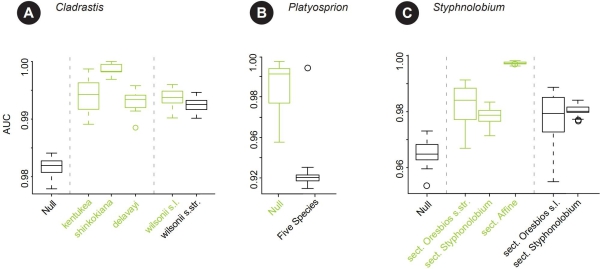

A recent research, solved the taxonomic problems of the tribe Cladrastideae (Fabaceae), was published in Taxon by Dr. DUAN Lei under the guidance of professor CHEN Hong-Feng from South China Botanical Garden of the Chinese Academy of Sciences, and professor WEN Jun from Smithsonian Institution.
The Cladrastis clade is an early-diverged lineage within the subfamily Papilionoideae of Leguminosae. Several taxonomic uncertainties limit a robust understanding of its taxonomy, such as should the genus Platyosprion be resurrected, how should Cladrastis be delimited to maintain the generic monophyly and is Styphnolobium best classified into two or three sections.
Researchers assessed specific/sectional/generic boundaries within this clade by integrating evidence from phylogenetic analyses, morphology, and multivariate ecological methods. With an extensive sampling, they reconstructed the phylogenies of the clade.
Based on environmental data for 841 occurrences, clusters of species were sought according to their environmental preferences with the principal component analysis (PCA), and explicit hypotheses on species/sectional boundaries were tested using ecological niche modeling (ENM). A new tribe, Cladrastideae, is established based on the Cladrastis clade with four monophyletic groups: the Cladrastis platycarpa complex, Cladrastis s.str., Pickeringia and Styphnolobium. The C. platycarpa complex constitutes the resurrected genus Platyosprion. The putative species C. chingii, C. parvifolia, C. scandens and C. yungchunii are suggested to be treated as synonyms of Platyosprion platycarpum. Cladrastis is recircumscribed as equal to Cladrastis s.str., with three species from eastern Asia, and one species, C. kentukea, from eastern North America. Styphnolobium is herein classified into three sections: St. sect. Oresbios, St. sect. Styphnolobium and a new section, St. sect. Affine. The broadly cultivated horticultural "Japanese pagoda tree", Styphnolobium japonicum, is the only extant Asian species of St. sect. Styphnolobium.
Previously, very few cases studied taxonomic questions using ecological analyses, especially ENM. Researchers designed specific hypothesis-based modeling scheme for each genus, of which results were largely consistent with the phylogenetic analyses. Thus, their study may provide an alternative idea that ENM may solve taxonomy issues in plants, at least as additional evidence.
For further reading, please refer to: https://doi.org/10.1002/tax.12155.

Figure. Ecological niche modeling (ENM) analyses of the taxonomic hypotheses.

